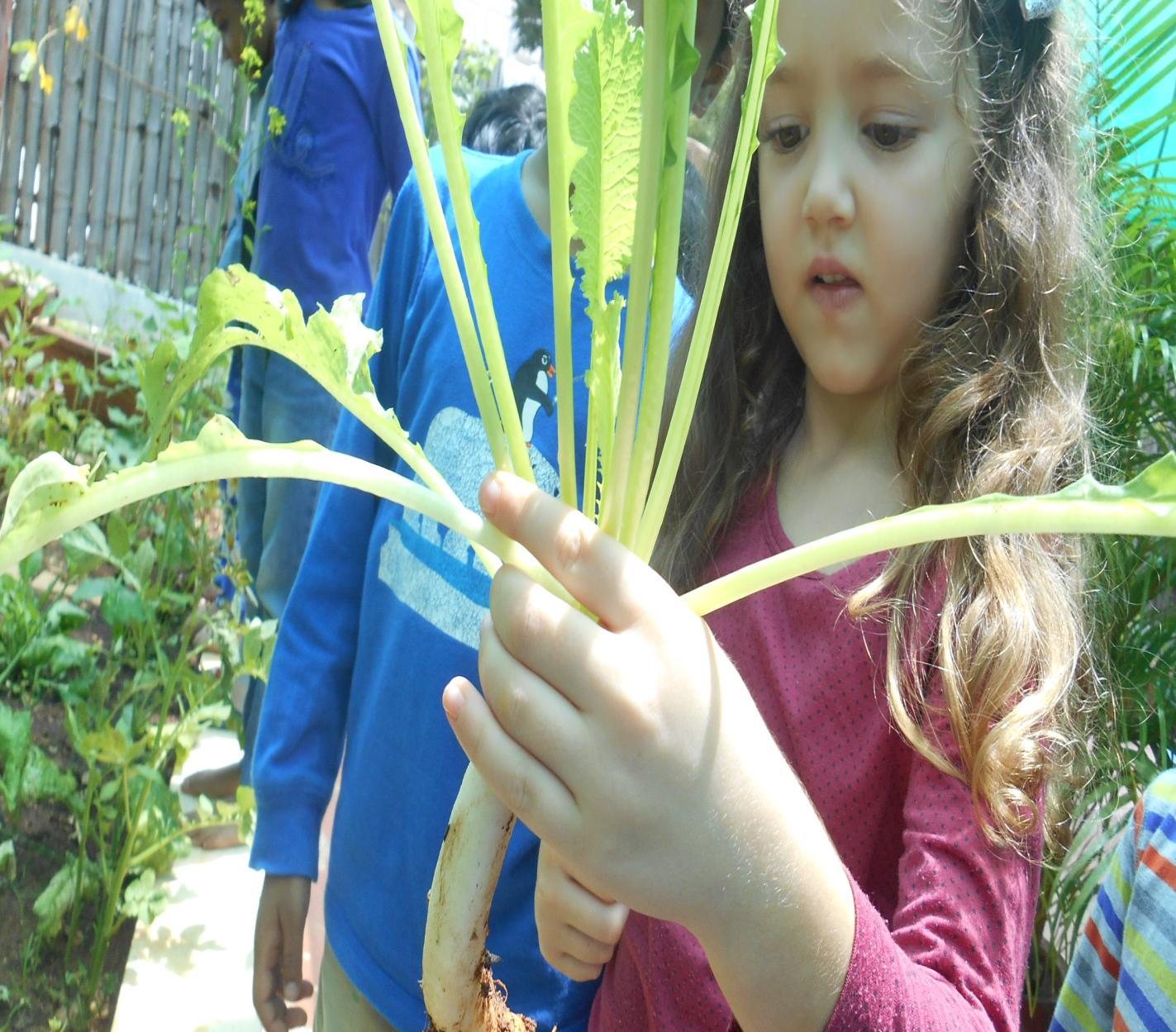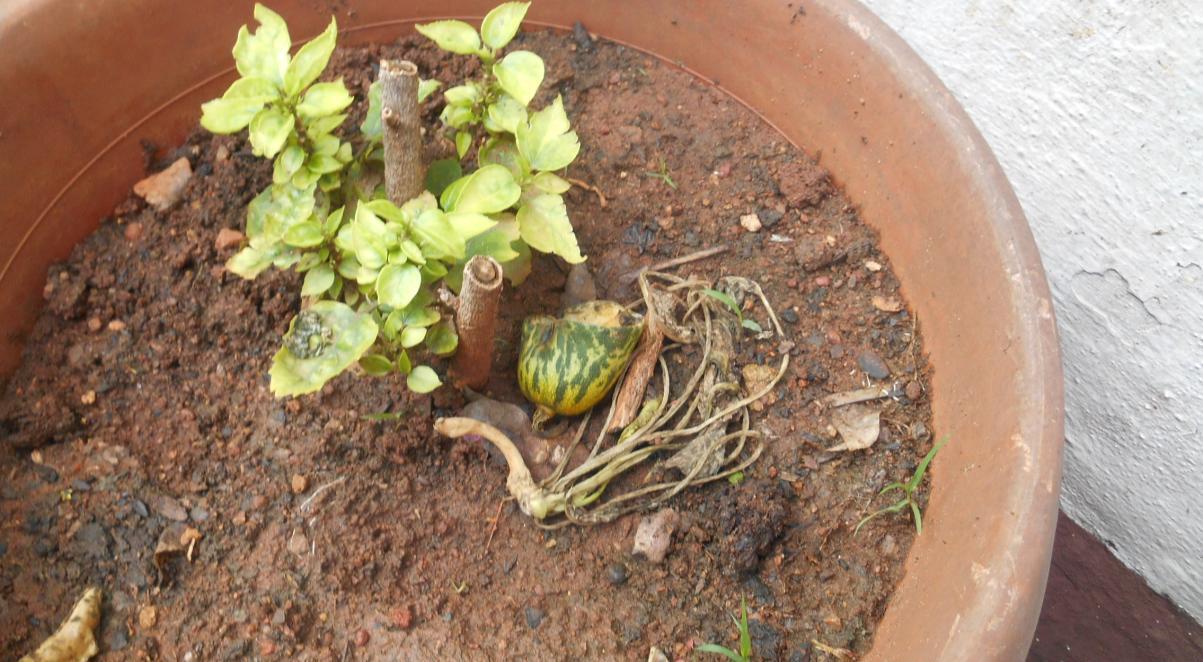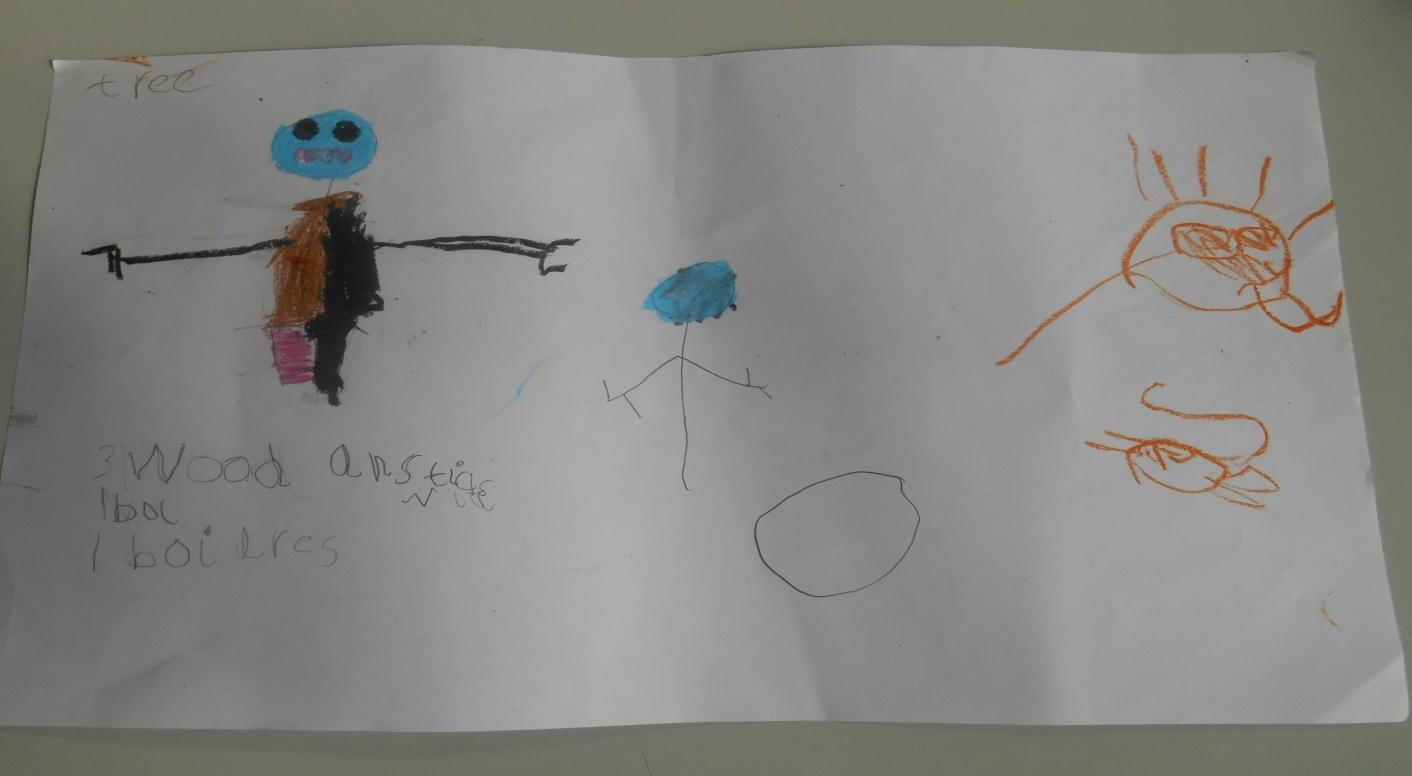Who has been eating our vegetables?
A learning portrait by K1



This learning portrait supports how teacher facilitates the student-initiated inquiry of class K1 to find the solution to the problem they were facing. The discussion helped the learners to make connections of their prior knowledge, experiences to the current situation and share their ideas effectively in the whole group.
As a part of the unit on ‘Farm to table’ the children of K1 class were inquiring into various aspects of learning like growth of a plant, the sources of our food and the changes in the food before we eat them. The inquiry into farm to table led to another inquiry generated by children to find out the solution to a problem the class was facing- animal eating up their vegetables from the garden. How can kindergarteners engage themselves and their peers in small group learning and then involve the whole class? How can teachers facilitate the learning and engage the whole class of 34 children to solve the mystery! The kindergarten became detective to solve this problem.


At the beginning of the session the teachers of class K1 decided to invite the gardener to come and visit the school as an expert. The children brought various kinds of seeds from home to grow their own kitchen garden in school. The gardener’s visit at school was intentional to understand the growth of a plant, to plant and grow their own vegetables and to use them in their kitchen role-play to make food.







Look, how the seeds are grown inside the bean ?



We can see some of the fruits growing so fast…..





The cucumber is half eaten and thrown in the pot!
Carrots were missing too!

There is a big hole in the mud..

‘Who has been coming to our garden and eating our vegetables?’


• Teacher: What do you think must be happening to our vegetables; I am wondering who could be eating our vegetables when we are not in the school?
• Jayden: “It could be a big rat whose coming only in the night”
• Nilesh: or a monkey,
• Dhashaarya:I think it’s a snake, It could be rabbit as the carrots are missing from the garden.
• Hiya: or insects from below the ground who likes only spinach, carrots.
The responses from children and their curiosity helped teacher to document their learning. The different perspectives helped to strategies their thinking.
The adult nurtured their capacities to learn together
The goal of next session was to bring together these perspectives and to further come up with strategies to solve the problem.
• Teacher: How could we find out the animal coming and eating up our vegetables and what could we do to prevent this.
• Arav: “We can build a fort, I have seen in the movie”
• Aneeka: “Put a net but net is not a good idea mouse has sharp teeth it can open the net”
• Tia: “We can build a wooden wall”
• Gyaan: “Build a brick wall as in the story ‘Three little pigs, it’s the strongest material”
• Samaira: “Some kind of gate without holes”
• Hiya: “If we put a big tree animals may not go”
• Jayden: “We can have a special camera to spy it and there can many traps”
• Dhashaarya : “We can have a cc camera with torch , this should be down and we’ll see who is it and then we can catch it call the forester and he will leave it in the zoo”
Learning is purposeful, shaped by the passion and interests of teachers and children. The inquiry carried out everyday! It is amazing to see the interest and curiosity continued even in the 15 days of Dussera break. The first question as they arrived was ‘what happened to our garden, did we find anything in the camera?’
• Kiara:- “We can put a scarecrow?”
• Jayden: “How about having a laser shooter that can shoot the eye?”
• Teacher: I think, shooting may not be a good idea, we will catch the animal without hurting them. Have you ever did this?
• Arav: “Remove all the mud and put them again after putting a net below if its something that’s coming from the soil and then put all the mud and the plants again”
• Aryav: “We could also put some fire, I have seen in the farm, they burn the farm and put them again, it will scare the animal from the ground and they will run away”
• Nilay: “We could put some injections in the mud so that they if they get hurt , they will get better and faster they will come out!”
• Rhea: “The stick tape to catch mouse might help, I have seen at home behind my sofa we did the something and got the mouse.




I think, putting electric fencing will scare the animal but we also need CC tv camera.


To make scarecrow we need 3 things….




Here I am taking care of garden in school, sticky pad is in the soil to catch the mouse…



We can put blue net under the soil to prevent it coming from ground, I think it’s a snail who is eating beans and tomatoes.


• Scarecrow team- To scare away the animal
• Catch the animal team- To catch the animal
• CCTV camera team- To see which animal

What do we need to make scarecrow, lets make a list !




Making scarecrow sculpture using different material


Our scarecrow is ready!



We will put the smallest sticky pad under the cupboard, the medium thin one under the table and the biggest near the garden so that he will not escape.


Let’s see if we got anything on the sticky pad today.





This group of K1 children did an experiment to try out various types of food to see if they could catch an animal. This continued for a week. Learners tried variety of food like dosa, cheese, tomato. Tomato was chosen as it was the food what mice loved to eat from garden the most.



Oh! we can’t see the small things in the camera, can we have one camera very close to the garden?
Teacher: we can’t immediately put a camera near the garden as it will take some time. What else can be done?
Arav and Jayden: We will come in the night with our parent in school with torch and catch the animal, my dad can make a plan to catch it.
Teacher: We are not allowed to come to school in the night but there is a security who takes care of school all the time.
Arav and Ritvi: Can we ask him then?
Teacher: Yes of course we can do that! Let’s write a letter to him and ask for help.
Dear Security uncle,
Please make sure when we are not in school, no animal comes and eat our vegetables. You can go near the garden without making any noise and catch it if you can.
Thanks
K1 children

Anika: My mom told if we spray some kind of medicine on the food, animal will not eat that and they will go away.
Arav: My driver told me the mice like boiled rice, tomato and cucumber, if we put them in the cage, they will come to eat that and get trap.




Learning is an emotional and social act. Learning here involved listening and considering multiple points of view and interpretation which led to further inquiry. Meaning emerged from reflecting and revisiting one’s knowledge and sharing with entire group. Teacher team showed empathy towards nature and thus bringing caring and sustainability concept, our role in taking care of nature around us came out in the conversation with the children. Teacher learned together by comparing observation of student’s learning in order to design the next step of the project.
The discussion on ‘Who has been eating our vegetable form our gardener’ was the learning moment for the learners in this learning group. In a group they were actively involved, shared their ideas effectively and listened to each other’s point of view. The movement between these contexts provided opportunities for learning and reflection.